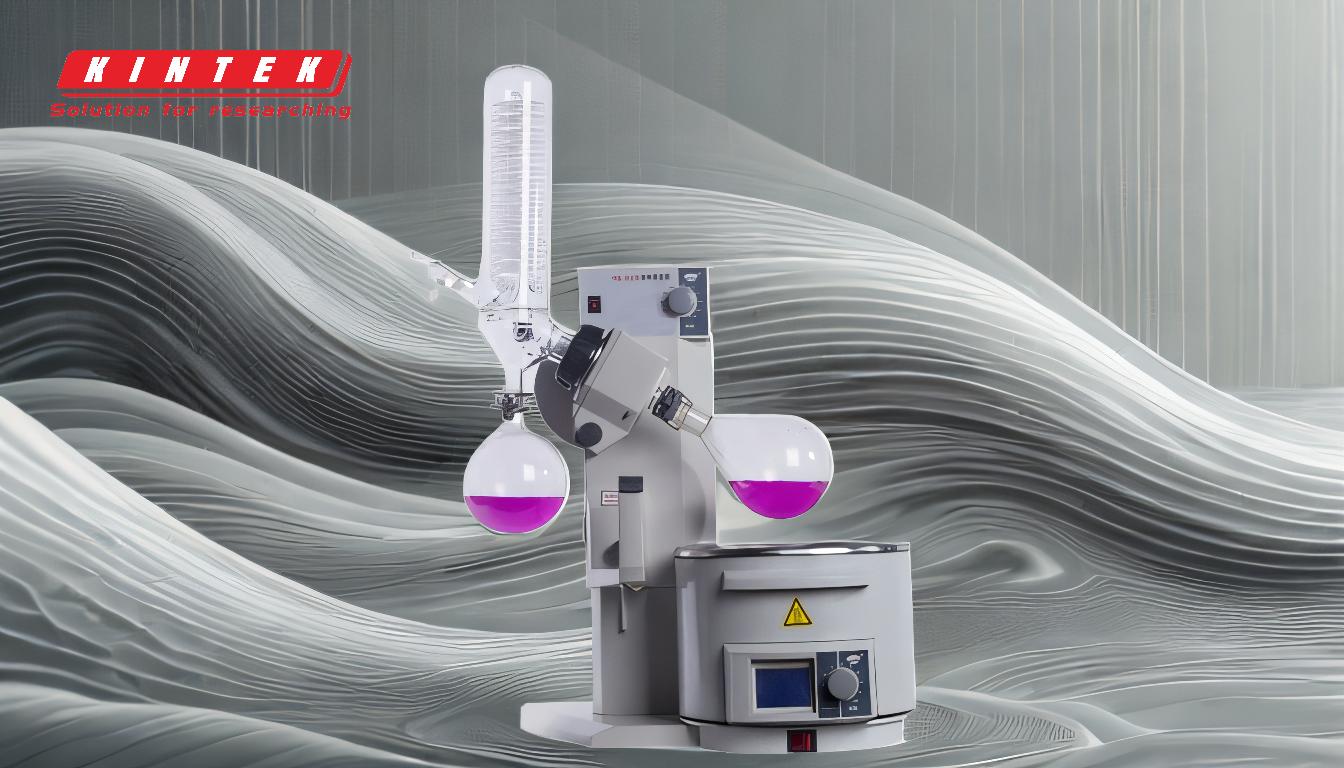A rotary evaporator, commonly referred to as a "rotovap," is a laboratory instrument used for efficient and gentle removal of solvents from samples through evaporation. Its basic principles revolve around vacuum distillation, enhanced surface area, and controlled heating. The process involves rotating a flask under vacuum conditions, which lowers the boiling point of the solvent, allowing it to evaporate at lower temperatures. The rotation creates a thin film of the sample on the flask wall, increasing the surface area for evaporation and ensuring uniform heating. The evaporated solvent is then condensed and collected, leaving behind the desired product. This method is particularly useful for heat-sensitive materials and volatile solvents, as it minimizes thermal degradation and ensures efficient separation.
Key Points Explained:

-
Vacuum Distillation:
- The rotary evaporator operates under high vacuum conditions (typically around 1 torr), which significantly reduces the boiling point of solvents. This allows solvents to evaporate at much lower temperatures than their standard boiling points, preventing thermal degradation of heat-sensitive materials.
- For example, solvents like dimethylformamide (DMF) and dimethyl sulfoxide (DMSO), which have high boiling points at atmospheric pressure, can be distilled at lower temperatures (e.g., 50°C) under reduced vacuum (5 torr).
-
Rotation Mechanism:
- The flask containing the sample rotates at a constant speed, creating a thin, uniform film of the sample on the inner wall of the flask. This rotation increases the surface area available for evaporation, significantly speeding up the process.
- The rotation also ensures even mixing and uniform heating, reducing the risk of localized overheating or "bumping," which can occur when a liquid boils unevenly.
-
Uniform Heating:
- The rotating flask is heated by a constant-temperature water or oil bath. This ensures that the sample is heated evenly, further reducing the risk of thermal degradation.
- The combination of vacuum and controlled heating allows for gentle evaporation, making the rotary evaporator ideal for volatile and heat-sensitive compounds.
-
Condensation and Collection:
- The evaporated solvent vapor is cooled by a glass condenser, which converts it back into a liquid. The condensed solvent is then collected in a separate flask, allowing for easy recovery and reuse of the solvent.
- This step is crucial for ensuring the purity of the final product and for solvent recovery in environmentally friendly laboratory practices.
-
Enhanced Efficiency:
- The combination of vacuum, rotation, and uniform heating significantly enhances the efficiency of the evaporation process. The large surface area created by the rotating flask allows for rapid evaporation, even for solvents with high boiling points.
- This makes the rotary evaporator a preferred tool for tasks such as solvent removal, concentration of solutions, and purification of reaction products.
-
Applications:
- The rotary evaporator is widely used in chemistry, biochemistry, and pharmaceutical laboratories for tasks such as:
- Solvent removal from reaction mixtures.
- Concentration of samples for analysis.
- Purification of compounds through distillation.
- Recovery of solvents for reuse, reducing waste and costs.
- The rotary evaporator is widely used in chemistry, biochemistry, and pharmaceutical laboratories for tasks such as:
-
Advantages:
- Gentle Evaporation: The low-temperature evaporation process minimizes the risk of degrading heat-sensitive materials.
- Efficiency: The large surface area and uniform heating ensure rapid and efficient evaporation.
- Versatility: Suitable for a wide range of solvents, including volatile and high-boiling-point solvents.
- Environmental Benefits: Solvent recovery reduces waste and promotes sustainable laboratory practices.
In summary, the rotary evaporator is a versatile and efficient tool that leverages the principles of vacuum distillation, enhanced surface area, and controlled heating to gently and effectively separate solvents from samples. Its design and operation make it indispensable in laboratories dealing with heat-sensitive materials, volatile solvents, and the need for efficient solvent recovery.
Summary Table:
| Key Feature | Description |
|---|---|
| Vacuum Distillation | Reduces solvent boiling points, enabling low-temperature evaporation. |
| Rotation Mechanism | Creates a thin film for increased surface area and uniform heating. |
| Uniform Heating | Ensures gentle evaporation, ideal for heat-sensitive materials. |
| Condensation | Collects and recycles solvents, promoting sustainability. |
| Applications | Solvent removal, sample concentration, purification, and solvent recovery. |
| Advantages | Gentle, efficient, versatile, and environmentally friendly. |
Optimize your lab processes with a rotary evaporator—contact us today to learn more!











